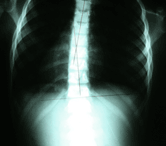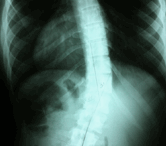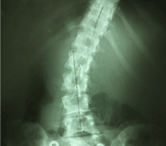Scoliosis is a condition in which an individual’s spine has lateral, or side to side curvature. On an x-ray, scoliosis curves can often look like a simple “S” or a “C” shape.
Scoliosis curves can actually occur at many levels of the spine; the cervical/neck region, thoracic/rib region and lumbar/low back region. As well as, also occurring at multiple regions in the same individual. Some patterns of scoliosis curves are more common than others, but hardly ever are two patients’ spines identical.
80-85% of scoliosis cases are idiopathic (meaning the cause is unknown):
Idiopathic scoliosis is classified into subcategories – infantile, juvenile, adolescent, or adult, depending on when onset the onset of scoliosis occurs.
Scoliosis can also be classified as congenital or neuromuscular:
Congenital – caused by vertebral anomalies that occur during embryological development and may be accompanied by other organ anomalies.
Neuromuscular – where scoliosis is a secondary symptom of another condition such as muscular dystrophy, cerebral palsy and others.
Degrees of Scoliosis
Scoliosis curve 10° to 25°
Mild Scoliosis has a significant risk of progression – up to 22%
Once Scoliosis passes 20° risk of progression more than triples to 68%
Scoliosis curve 26° to 40°
Moderate Scoliosis has a 68% chance of progression
Scoliosis curve above 40°
Severe Scoliosis has a 90% risk of progression
Symptoms of Mild Stage Scoliosis
- Scoliosis curve is less than 25°.
- May have tilted head, uneven shoulders or hips.
- Head may appear forward of shoulders (“Forward Head Posture”) when viewed from the side
- Clothing may hang unevenly.
- May have uneven leg lengths (with patient laying straight on the floor or bed, observe where the shoes meet).
- May go unnoticed, even by medical doctors or school screeners.
- May or may not be associated with pain.
- Most common in young, premenstrual girls, but can be seen in boys or adults.
Benefits of Mild Stage Scoliosis Treatment
- Easy to overcome when the curve is small.
- Cosmetic deformity is a much greater concern at this stage.
- More energy.
- Scoliscore test may be used to determine propensity of progression (99% accuracy) without the need for diagnostic X-Rays
The CLEAR™ methodology offers the only mild scoliosis treatment program available today. CLEAR’s program is non-invasive, pro-active and is specifically designed to address the treatment needs of patients with a developing scoliosis condition. The CLEAR™ program has corrected thousands of mild scoliosis curves. Enrolling your son or daughter in our mild scoliosis treatment program will provide them with the best opportunity to reduce and stabilize their spinal curve before it progresses.



